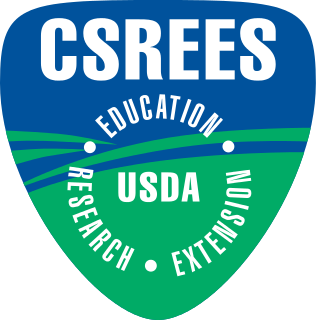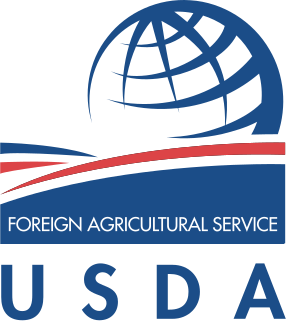
The Agricultural Research Service (ARS) is the principal in-house research agency of the United States Department of Agriculture (USDA). ARS is one of four agencies in USDA's Research, Education and Economics mission area. ARS is charged with extending the nation's scientific knowledge and solving agricultural problems through its four national program areas: nutrition, food safety and quality; animal production and protection; natural resources and sustainable agricultural systems; and crop production and protection. ARS research focuses on solving problems affecting Americans every day. The ARS Headquarters is located in the Jamie L. Whitten Building on Independence Avenue in Washington, D.C. and the headquarters staff is located at the George Washington Carver Center (GWCC) in Beltsville, Maryland. For 2018, its budget was $1.2 billion.

The Environmental Working Group (EWG) is an American activist group that specializes in research and advocacy in the areas of agricultural subsidies, toxic chemicals, drinking water pollutants and corporate accountability. EWG is a non-profit organization.

The Federal Insecticide, Fungicide, and Rodenticide Act (FIFRA) is a United States federal law that set up the basic U.S. system of pesticide regulation to protect applicators, consumers, and the environment. It is administered and regulated by the United States Environmental Protection Agency (EPA) and the appropriate environmental agencies of the respective states. FIFRA has undergone several important amendments since its inception. A significant revision in 1972 by the Federal Environmental Pesticide Control Act (FEPCA) and several others have expanded EPA's present authority to oversee the sales and use of pesticides with emphasis on the preservation of human health and protection of the environment by "(1) strengthening the registration process by shifting the burden of proof to the chemical manufacturer, (2) enforcing compliance against banned and unregistered products, and (3) promulgating the regulatory framework missing from the original law".

The National Agricultural Statistics Service (NASS) is the statistical branch of the U.S. Department of Agriculture and a principal agency of the U.S. Federal Statistical System. NASS has 12 regional offices throughout the United States and Puerto Rico and a headquarters unit in Washington, D.C.. NASS conducts hundreds of surveys and issues nearly 500 national reports each year on issues including agricultural production, economics, demographics and the environment. NASS also conducts the United States Census of Agriculture every five years.
The Commodity Credit Corporation (CCC) is a wholly owned United States government corporation that was created in 1933 to "stabilize, support, and protect farm income and prices". The CCC is authorized to buy, sell, lend, make payments, and engage in other activities for the purpose of increasing production, stabilizing prices, assuring adequate supplies, and facilitating the efficient marketing of agricultural commodities.

Food policy is the area of public policy concerning how food is produced, processed, distributed, and purchased. Food policies are designed to influence the operation of the food and agriculture system. This often includes decision-making around production and processing techniques, marketing, availability, utilization and consumption of food, in the interest of meeting or furthering social objectives. Food policy can be promulgated on any level, from local to global, and by a government agency, business, or organization. Food policymakers engage in activities such as regulation of food-related industries, establishing eligibility standards for food assistance programs for the poor, ensuring safety of the food supply, food labeling, and even the qualifications of a product to be considered organic.
Food politics are the political aspects of the production, control, regulation, inspection, distribution and consumption of food. The politics can be affected by the ethical, cultural, medical and environmental disputes concerning proper farming, agricultural and retailing methods and regulations.

The Federal Agriculture Improvement and Reform Act of 1996, known informally as the Freedom to Farm Act, the FAIR Act, or the 1996 U.S. Farm Bill, was the omnibus 1996 farm bill that, among other provisions, revises and simplifies direct payment programs for crops and eliminates milk price supports through direct government purchases.

Inter-Regional Research Project Number 4 is an agricultural program of the USDA Cooperative State Research, Education, and Extension Service which has been in effect since 1963. IR-4 works in coordination with the Environmental Protection Agency to assist in the collection of residue and efficacy data in support of the registration or reregistration of minor use pesticides and the determination of tolerances for residues of minor use chemicals in or on raw agricultural commodities. IR-4's mission is to facilitate registration of sustainable pest management technology for fruits, vegetables, ornamental plants, and other "minor" crops, i.e. high in value but not widely grown in the United States. While most of the minor uses investigated are small enough that it is not profitable for private business to establish the acceptability of a pesticide for individual specialty crops, collectively the specialty crops covered by the project make up almost half of U.S. agricultural crop production and over $40 billion in sales.
In different administrative and organizational forms, the Food for Peace program of the United States has provided food assistance around the world for more than 50 years. Approximately 3 billion people in 150 countries have benefited directly from U.S. food assistance. The Office of Food for Peace within the United States Agency for International Development (USAID) is the U.S. Government's largest provider of overseas food assistance. The food assistance programming is funded primarily through the Food for Peace Act. The Office of Food for Peace also receives International Disaster Assistance Funds through the Foreign Assistance Act (FAA) that can be used in emergency settings.
The Texas Department of Agriculture (TDA) is a state agency within the state of Texas, which is responsible for matters pertaining to agriculture, rural community affairs, and related matters.
Pesticides in the United States are used predominantly by the agricultural sector, but approximately a quarter of them are used in houses, yards, parks, golf courses, and swimming pools.
The Agricultural Resource Management Survey is the United States Department of Agriculture’s primary source of information on the financial condition, production practices, resource use, and economic well being of America’s farm households. Sponsored jointly by the Economic Research Service (ERS) and the National Agricultural Statistics Service (NASS), ARMS began in 1996, as a synthesis of the former USDA cropping practice, chemical use, and farm costs and returns surveys, which dated back to 1975. ARMS data underpin USDA’s annual estimates of net farm income and fulfills a congressional mandate that USDA provide annual cost-of-production estimates for commodities covered under farm support legislation. ARMS also provides data regarding chemical use on field crops required under environmental and food safety legislation.
The American Egg Board (AEB) is a United States checkoff marketing organization, which focuses on marketing and promotion of eggs for human consumption. The AEB is best known for its long-running slogan, "The Incredible, Edible Egg", and the Just Mayo scandal.

Pesticide regulation in the United States is primarily a responsibility of the Environmental Protection Agency.
Dietary exposure assessments involve the evaluation of dietary consumption and chemical residue data while taking into consideration additional factors that may affect a specified population of interest or sensitive population. The process of conducting a dietary exposure assessment involves the determination of the chemical residues on a particular food or foods and the calculation of the dietary exposure to these chemicals based on consumption data for the specified food or foods. In the most simplified form, a dietary exposure assessment can be summarized with the following calculation:

The Cooperative State Research, Education, and Extension Service (CSREES) is an extension agency within the U.S. Department of Agriculture (USDA), part of the executive branch of the federal government. The 1994 Department Reorganization Act, passed by Congress, created CSREES by combining the former Cooperative State Research Service and the Extension Service into a single agency.













